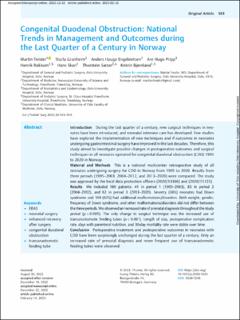| dc.contributor.author | Treider, Martin | |
| dc.contributor.author | Granheim, Sturla | |
| dc.contributor.author | Engebretsen, Anders Hauge | |
| dc.contributor.author | Pripp, Are Hugo | |
| dc.contributor.author | Røkkum, Henrik | |
| dc.contributor.author | Skari, Hans | |
| dc.contributor.author | Sæter, Thorstein | |
| dc.contributor.author | Bjørnland, Kristin | |
| dc.date.accessioned | 2024-04-11T13:54:54Z | |
| dc.date.available | 2024-04-11T13:54:54Z | |
| dc.date.created | 2023-02-13T14:23:18Z | |
| dc.date.issued | 2023 | |
| dc.identifier.citation | European journal of pediatric surgery. 2023, 33 (06), 503-509. | en_US |
| dc.identifier.issn | 0939-7248 | |
| dc.identifier.uri | https://hdl.handle.net/11250/3126170 | |
| dc.description.abstract | Introduction During the last quarter of a century, new surgical techniques in neonates have been introduced, and neonatal intensive care has developed. Few studies have explored the implementation of new techniques and if outcomes in neonates undergoing gastrointestinal surgery have improved in the last decades. Therefore, this study aimed to investigate possible changes in postoperative outcomes and surgical techniques in all neonates operated for congenital duodenal obstruction (CDO) 1995 to 2020 in Norway. Material and Methods This is a national multicenter retrospective study of all neonates undergoing surgery for CDO in Norway from 1995 to 2020. Results from three periods (1995–2003, 2004–2012, and 2013–2020) were compared. The study was approved by the local data protection officers (2020/13386) and (2020/15125). Results We included 186 patients: 41 in period 1 (1995–2003), 83 in period 2 (2004–2012), and 62 in period 3 (2013–2020). Seventy (38%) neonates had Down syndrome and 104 (62%) had additional malformations/disorders. Birth weight, gender, frequency of Down syndrome, and other malformations/disorders did not differ between the three periods. We observed an increased rate of prenatal diagnosis throughout the study period (p < 0.001). The only change in surgical technique was the increased use of transanastomotic feeding tubes (p < 0.001). Length of stay, postoperative complication rate, days with parenteral nutrition, and 30-day mortality rate were stable over time. Conclusion Perioperative treatment and postoperative outcomes in neonates with CDO have been surprisingly unchanged during the last quarter of a century. Only an increased rate of prenatal diagnosis and more frequent use of transanastomotic feeding tubes were observed. Keywords ERAS - neonatal surgery - enhanced recovery after surgery - congenital duodenal obstruction - transanastomotic feeding tube | en_US |
| dc.description.abstract | Congenital duodenal obstruction - National trends in management and outcomes during the last quarter of a century in Norway | en_US |
| dc.language.iso | eng | en_US |
| dc.publisher | Thieme Gruppe | en_US |
| dc.title | Congenital duodenal obstruction - National trends in management and outcomes during the last quarter of a century in Norway | en_US |
| dc.title.alternative | Congenital duodenal obstruction - National trends in management and outcomes during the last quarter of a century in Norway | en_US |
| dc.type | Journal article | en_US |
| dc.type | Peer reviewed | en_US |
| dc.description.version | acceptedVersion | en_US |
| dc.rights.holder | © 2023. Thieme. All rights reserved. | en_US |
| dc.source.pagenumber | 503-509 | en_US |
| dc.source.volume | 33 | en_US |
| dc.source.journal | European journal of pediatric surgery | en_US |
| dc.source.issue | 06 | en_US |
| dc.identifier.doi | 10.1055/a-2003-1920 | |
| dc.identifier.cristin | 2125677 | |
| cristin.ispublished | true | |
| cristin.fulltext | postprint | |
| cristin.qualitycode | 1 | |
